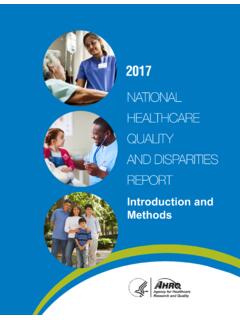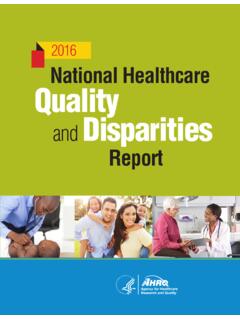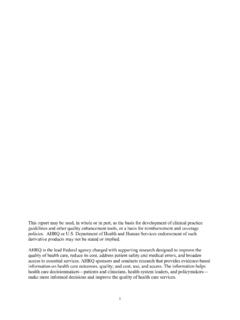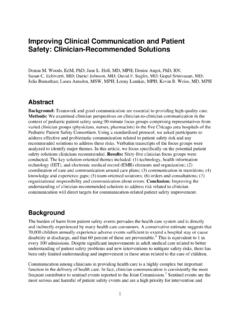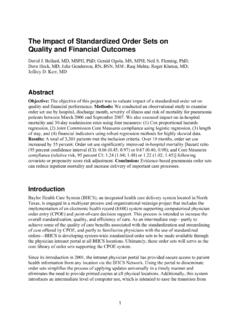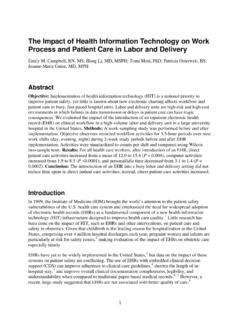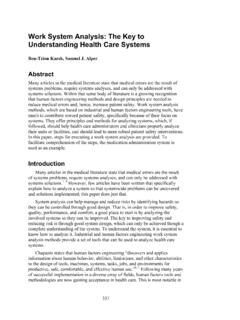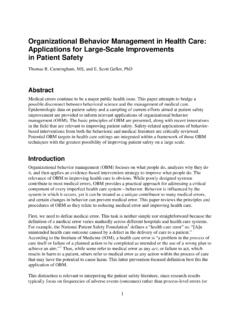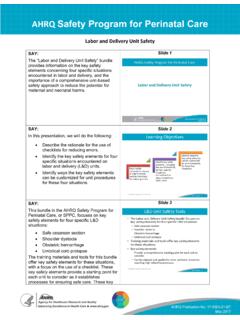Transcription of The Patient-Centered Medical Home: Strategies to Put ...
1 Patient-Centered Medical Home Decisionmaker BriefThe Patient-Centered Medical Home: Strategies to Put patients at the Center of Primary Care Question:How can decisionmakers encourage the Patient-Centered Medical home (PCMH) to respond to and reflectthe goals, preferences, and needs of patients and their families?Answer: patients involvement in the Medical home should take place on three levels: 1) engagement in their own care, 2) quality improvement (QI) in the primary care practice, and 3) development and implementation of policy and research. Decisionmakers can promote greater patient engagement at all three levels. Opportunities include: Requiring primary care practices to demonstrate active engagement of patients and families in patient care and QIactivities in order to qualify as Medical homes. Using payment Strategies to support the active engagement of patients as partners in their own care and inpractice-level QI.
2 Supporting practices with technical assistance, tools, and shared resources to engage patients . Requiring health information technology (IT) standards to recognize and promote patient engagement. Requiring meaningful patient input in the design, implementation, and evaluation of Medical home programs. Supporting additional research on the feasibility and impact of patient-engagement PCMH is a promising model that aims to systems-based approach to quality and safetythatthe health care system by reorganizing the way primary careincludes gathering and responding to patient experiencepractices provide ,2A Medical home is supported bydata, a commitment to ongoing quality improvement,health IT and payment reform and rests on five pillars3: and practicing population health management. Patient-Centered orientationtoward each patient sMany believe the PCMH model can achieve its objectivesunique needs, culture, values, and preferences; support ofonly by fully engaging patients .
3 However, patients arethe patient s self care efforts; and involvement of theunlikely to be familiar with this model of care and may thinkpatient in care the PCMH is simply a primary care gatekeeper with adifferent name. This brief outlines how decisionmakers , team-based carethat meets the largepromote a PCMH model that is truly Patient-Centered andmajority of each patient s physical and mental health carerepresents a genuine departure from the way care is oftenneeds, including prevention and wellness, acute care, care and is provided by a cohesive patients in the Medical Home at that is coordinatedacross all elements of theThree Levelscomplex health care system and connects patients to bothmedical and social resources in the can support primary care practices inengaging patients and families at three levels: 1) access to carethat meets patients needs andin their own care, 2) quality improvement in the primarypreferences, including care provided after hours and by care practice, and 3) policy and research development ande-mail and Advancing Excellence in Health for healthcare Research and QualityHealth ITPrevention/ Care Management1.
4 Involvement in the Care of Patients3. Involvement in the Development and Implementation of Policy and ResearchPrimary care practices can more actively engage patients andtheir families and caregivers in the management orDecisionmakers and researchers can engage patients ,improvement of their health in four ways:families, and organizations that represent them in policy andresearch so the design and study of the Medical home patients about how the PCMH patient perspectives. Without the explicit inclusion ofworks, the role of patients and providers, and whatpatients and families to articulate their needs andeach can expect of the other in this new model of care. perspectives, even the best-intentioned Medical home policy,b. Support patients in self-care. This support includesdesign, and research may miss the mark, resulting in system-helping all patients reduce risk factors, as well asand provider-centered care rather than Patient-Centered patients with chronic illnesses develop andEvidenceupdate self-care goals and care patients in the Medical home is seen by somec.
5 Partner with patients in formal and informalstakeholders as intrinsically valuable and as a model of caredecisionmaking. Shared decisionmaking is a formalthat should be pursued regardless of whether it lowers costsprocess in which patients review evidence-basedor improves health outcomes. Others believe that decisionsdecision aids to understand the likely outcomes ofabout investing in patient engagement in health caredifferent treatment options; discuss with a health careshould be based on evidence of increased value. provider what is personally important to them aboutthe risks and benefits of different options; and thenEvidence exists regarding the benefits of engaging patientsdecide how to proceed, in collaboration with andin their own care, but more research is needed to identifyactively supported by providers. Informally, providingsustainable approaches and ways to adapt these approachesevidence-based information, discussing the pros andto various primary care settings.
6 Little evidence is availablecons of different options, asking about patientregarding the effects of engaging patients in practice-levelpreferences, and collaborating in decisions can improveQI or in policy and research. Useful examples do exist,a variety of health care decisions. however, of innovators engaging patients at all three levels. d. Improve patient safetyby giving patients access to theirSummaries of evidence and examples of innovativemedical records so they can detect and prevent errors,approaches to patient engagement are available in theand by including patients in areas such as: safecompanion white paper to this use, infection control initiatives, andStrategy Optionsreporting complications or put patients at the center of the PCMH, decisionmakers2. Involvement in quality Improvement in the could take the following steps:Primary Care Practice1.
7 Require that practices demonstrate the activePractices can engage patients in ongoing qualityengagement of patients and families in patient care andimprovement efforts in a variety of ways, includingquality improvement activities in order to qualify assoliciting regular feedback through surveys, gatheringmedical of the current qualification toolsadditional information on patient perspectives through thecould be modified so practices would need to demonstrateformation of patient/family advisory councils, and invitingthat they are actively obtaining and acting on feedback individual patients and consumer and patient organizationsto contribute to QI activities. 1 Scholle SH, Torda P, Peikes D, Han E, Genevro J. Engaging patients andFamilies in the Medical Home. AHRQ Publication No. , MD: Agency for healthcare Research and quality .
8 June patients such as through patient experience surveys,that have begun to provide technical assistance for practicefocus groups, or patient advisory councils to qualify as transformation. The Health IT Regional Extension Centersa PCMH. could also reinforce the use of health IT that supportspatient engagement. The work of these two programs2. Use payment Strategies to support the engagement ofshould also be guided by patients , families, andpatients and families in patient care and qualityorganizations that represent them, through their inclusion asimprovement Strategies can be designedmembers of policy councils or other decisionmaking bodies. to compensate and incentivize practices to engage patientsas active partners in their own care (such as through4. Establish meaningful-use and certificationpayment for self-management support, sharedrequirements to ensure health IT promotes patientdecisionmaking processes, and care coordination) and and State efforts to promotereward practices for implementing and maintainingmeaningful use of health IT provide important opportunitiesprocesses to engage patients in practice-level harness its capacity to support patient engagement byEngagement processes may require additional costs and maykeeping patients better informed of the contents of theirrequire a change in practice culture.
9 Options formedical records and their care plans. At the Federal and Stateincentivizing practices to actively involve patients includelevels, increased patient engagement is highlighted byadditional fee-for-service payments, bundled payments, andmeaningful-use measures that address such topics asperformance bonuses (for example, for higher patient-provision of an after-visit summary. These efforts to usesatisfaction ratings). health IT need to be built with input from patients . Federalrequirements under the American Recovery and3. Provide practices with technical assistance, tools, andReinvestment Act for demonstrating meaningful use byshared resources to:individual providers in future years (2015 and beyond) can Assess their current patient engagement policies andmake use of ongoing experience and research to includepractices and develop improvement measures of patient engagement.
10 Meaningful-userequirements will need to be updated as new health IT Engage patients in discussing what they can expect andoptions emerge, such as customized health coaching toolswhat might be expected of them in the applications on smart phones. Assess patients readiness for self-care, and provide self-management Require substantive patient input in the design,implementation, and evaluation of Medical home Improve staff communication skills using provide the opportunity tosuch as motivational interviewing and reflectivedevelop and assess patient engagement Strategies in all of discussed above. Support shared decisionmaking. 6. Support additional research on the feasibility and Obtain and use patient feedback in QI. Decisionmakersimpact of patient-engagement promisingcould fund the development of survey instruments andpatient-involvement Strategies described above may help putthe use of low-cost or shared data collection services.
